A) 10
B) 20
C) 40
D) 50
F) A) and D)
Correct Answer

verified
B
Correct Answer
verified
Multiple Choice
Figure 21-10 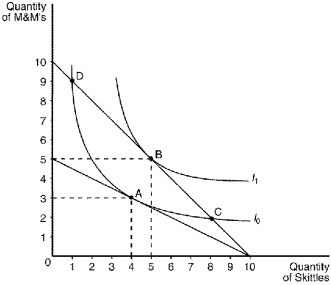 -Refer to Figure 21-10.Assume that the consumer depicted in the figure has an income of $50.The price of Skittles is $5 and the price of M&M's is $5.This consumer will choose a consumption bundle where the marginal rate of substitution is
-Refer to Figure 21-10.Assume that the consumer depicted in the figure has an income of $50.The price of Skittles is $5 and the price of M&M's is $5.This consumer will choose a consumption bundle where the marginal rate of substitution is
A) 10
B) 5
C) 1
D) 1/5.
F) A) and C)
Correct Answer

verified
Correct Answer
verified
Multiple Choice
When a consumer experiences a price decrease for an inferior good,it is possible that the income effect is
A) less than the substitution effect,and the demand curve will be downward sloping.
B) greater than the substitution effect,and the demand curve will be upward sloping.
C) less than the substitution effect,and the demand curve will be upward sloping.
D) both a and b are correct.
F) All of the above
Correct Answer

verified
Correct Answer
verified
Multiple Choice
"Left" gloves and "right" gloves provide a good example of
A) perfect substitutes.
B) perfect complements.
C) negatively sloped indifference curves.
D) positively sloped indifference curves.
F) C) and D)
Correct Answer

verified
Correct Answer
verified
True/False
A rise in the interest rate will generally result in people consuming more when they are old if the substitution effect outweighs the income effect.
B) False
Correct Answer

verified
True
Correct Answer
verified
Multiple Choice
When leisure is a normal good,the income effect from a decrease in wages is evident in
A) a desire to consume more leisure.
B) a desire to consume less leisure.
C) an upward-sloping labor supply curve.
D) a shift in labor demand.
F) A) and D)
Correct Answer

verified
Correct Answer
verified
Multiple Choice
Figure 21-5 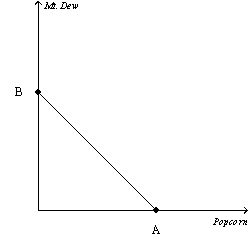 -Refer to Figure 21-5.Suppose a consumer has $200 in income,the price of popcorn is $1,and the price of Mt.Dew is $2.What is the value of A?
-Refer to Figure 21-5.Suppose a consumer has $200 in income,the price of popcorn is $1,and the price of Mt.Dew is $2.What is the value of A?
A) 200
B) 100
C) 50
D) 25
F) C) and D)
Correct Answer

verified
Correct Answer
verified
Multiple Choice
Suppose a consumer spends his income on CDs and DVDs.If his income decreases,the budget constraint for CDs and DVDs will
A) shift outward,parallel to the original budget constraint.
B) shift inward,parallel to the original budget constraint.
C) rotate outward along the CD axis because he can afford more CDs.
D) rotate outward along the DVD axis because he can afford more DVDs.
F) A) and B)
Correct Answer

verified
Correct Answer
verified
Multiple Choice
Economists represent a consumer's preferences using
A) demand curves.
B) budget constraints.
C) indifference curves.
D) supply curves.
F) All of the above
Correct Answer

verified
Correct Answer
verified
Multiple Choice
When the price of a good increases,all else equal,the higher price
A) reduces the consumer's set of buying opportunities.
B) leads to a parallel shift of the budget constraint.
C) will necessarily lead to an increase in the consumption of goods whose price did not change.
D) generally discourages the consumption of inferior goods.
F) B) and C)
Correct Answer

verified
Correct Answer
verified
Multiple Choice
A Giffen good is a good for which
A) a decrease in the price decreases the quantity demanded.
B) the substitution effect outweighs the income effect.
C) an increase in the price decreases the quantity demanded.
D) Both a) and b) are correct.
F) All of the above
Correct Answer

verified
Correct Answer
verified
Multiple Choice
At the consumer's optimum
A) the budget constraint will have a slope of MUx/Px.
B) the slope of the indifference curve is equal to the slope of the budget constraint.
C) the indifference curve will intersect the budget constraint at the midpoint of the budget constraint.
D) Both b and c are correct.
F) A) and D)
Correct Answer

verified
Correct Answer
verified
Multiple Choice
Suppose that you have $100 today and expect to receive $100 one year from today.Your money market account pays an annual interest rate of 25%,and you may borrow money at that interest rate.Consider the budget constraint between "spending today" on the horizontal axis and "spending a year from today" on the vertical axis.What is the slope of this budget constraint?
A) -0.75
B) -1.00
C) -1.25
D) -2.25
F) B) and C)
Correct Answer

verified
Correct Answer
verified
Multiple Choice
Figure 21-4 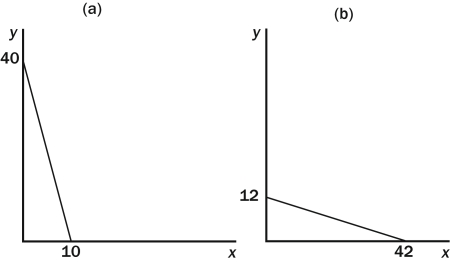 -Refer to Figure 21-4.Assume that a consumer faces both budget constraints in graph (a) and graph (b) on two different occasions.If her income has remained constant,what has happened to prices?
-Refer to Figure 21-4.Assume that a consumer faces both budget constraints in graph (a) and graph (b) on two different occasions.If her income has remained constant,what has happened to prices?
A) The price of X in graph (a) is higher than the price of X in graph (b) .
B) The price of Y in graph (a) is higher than the price of Y in graph (b) .
C) The prices of both X and Y are lower in graph (a) .
D) None of the above is true.
F) A) and D)
Correct Answer

verified
A
Correct Answer
verified
Multiple Choice
Figure 21-9 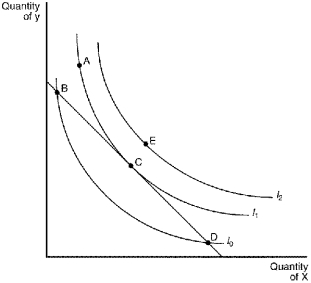 -Refer to Figure 21-9.It would be possible for the consumer to reach I2 if
-Refer to Figure 21-9.It would be possible for the consumer to reach I2 if
A) the price of Y decreases.
B) the price of X decreases.
C) income increases.
D) All of the above would be correct.
F) A) and C)
Correct Answer

verified
Correct Answer
verified
True/False
For a typical consumer,indifference curves can intersect if they satisfy the property of transitivity.
B) False
Correct Answer

verified
Correct Answer
verified
True/False
When two goods are perfect complements,the indifference curves are right angles.
B) False
Correct Answer

verified
Correct Answer
verified
Multiple Choice
Scenario 21-2 Fred has recently graduated from college with a degree in journalism and economics.He has decided to pursue a career as a freelance journalist writing for business newspapers and magazines.Fred is typically awake for 112 hours each week (he sleeps an average of 8 hours each day) .For each hour Fred spends writing,he can earn $75.Fred is such a good writer that he can get paid for as many hours of writing as he chooses to work. -Refer to Scenario 21-2.If Fred's wage increases to $90 per hour of writing,which of the following points would fall on his budget constraint?
A) 75 hours of leisure,$2,775 of consumption
B) 80 hours of leisure,$2,400 of consumption
C) 85 hours of leisure,$2,430 of consumption
D) 90 hours of leisure,$1,650 of consumption
F) A) and B)
Correct Answer

verified
Correct Answer
verified
Multiple Choice
Figure 21-6 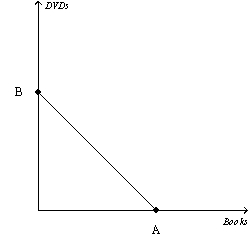 -Refer to Figure 21-6.Suppose a consumer has $500 in income,the price of a book is $10,and the value of B is 50.What is the price of a DVD?
-Refer to Figure 21-6.Suppose a consumer has $500 in income,the price of a book is $10,and the value of B is 50.What is the price of a DVD?
A) $5
B) $10
C) $50
D) $100
F) All of the above
Correct Answer

verified
Correct Answer
verified
Multiple Choice
Figure 21-4  -Refer to Figure 21-4.In graph (a) ,what is the price of good Y relative to good X (i.e. ,Py/Px) ?
-Refer to Figure 21-4.In graph (a) ,what is the price of good Y relative to good X (i.e. ,Py/Px) ?
A) 1/3
B) 1/4
C) 3
D) 4
F) B) and C)
Correct Answer

verified
Correct Answer
verified
Showing 1 - 20 of 354
Related Exams